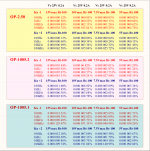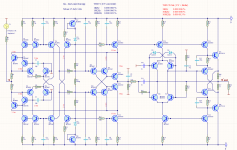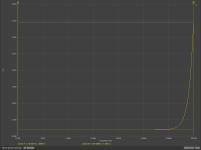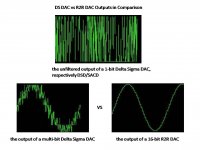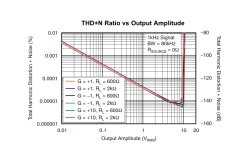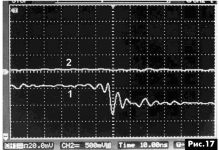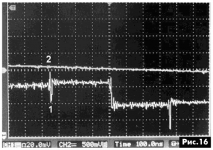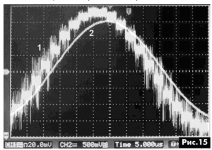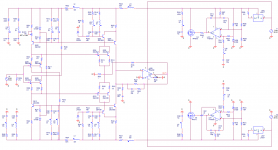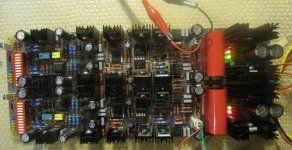Sandy,
Just from a technical point of view, wouldn’t it be fair to select a proper composite set of op-amps, to match your OP1005.
Just saying that one single opamp is no match at high gain might be true,
but using a properly matched set could bring the same level of performance as your discrete design.
This completely separated from the fact that nobody needs this kind of distortion and from costs issues, but it prevents creating the suggestion that in fact opamps are inferior.
Hans
Just from a technical point of view, wouldn’t it be fair to select a proper composite set of op-amps, to match your OP1005.
Just saying that one single opamp is no match at high gain might be true,
but using a properly matched set could bring the same level of performance as your discrete design.
This completely separated from the fact that nobody needs this kind of distortion and from costs issues, but it prevents creating the suggestion that in fact opamps are inferior.
Hans
I don't remember who said that there is nothing worse than arguing with someone who is smart, arrogant and ignorant.
None of my business but to those feel irritated by Sandy's posts and do not know him personally - please think of him as really smart, just a bit too arrogant and extremely knowledgeable and experienced. Why choose complex crazy schematics to achieve something that could be done much easier and simple another way? Because you can, because it is fun and probably there is something special that is to be found and experience drives your desire to do it that way. He is on the side of music but sometimes a fire starter too 🙂 .
None of my business but to those feel irritated by Sandy's posts and do not know him personally - please think of him as really smart, just a bit too arrogant and extremely knowledgeable and experienced. Why choose complex crazy schematics to achieve something that could be done much easier and simple another way? Because you can, because it is fun and probably there is something special that is to be found and experience drives your desire to do it that way. He is on the side of music but sometimes a fire starter too 🙂 .
Hans,
There are things that can not be done with discrete Tehonology.
There are things that can not be done by integrated teehonology.
Just knowing the possibilities of both technologies you can use them optimally.
There are things that can not be done with discrete Tehonology.
There are things that can not be done by integrated teehonology.
Just knowing the possibilities of both technologies you can use them optimally.
OP1005 is not a pure discreet amplifier.
For DC-10Hz there is an integral part of OPA333.
With what combination of integral circuits (compiled amplifier) you will achieve something close to the OP-2.50 per 100 ohm load and 30Vpp
The cost of the OP1005 is only 5 euros on 200 pieces made.
For DC-10Hz there is an integral part of OPA333.
With what combination of integral circuits (compiled amplifier) you will achieve something close to the OP-2.50 per 100 ohm load and 30Vpp
The cost of the OP1005 is only 5 euros on 200 pieces made.
Attachments
Last edited:
Calvin,
With my knowledge of English and your knowledge of electronics, we will find it difficult.
You know the electronics as I know the English.
And I English do not know 🙂
If you can show similar parameters with integrated circuits, I'll agree that's a bad thing.
Not even looking at the price.
With integrated circuits, it will be much more expensive, but I'll accept it.
Graph of input resistance 1ohms for 10Hz-1MHz
17.2 ohms for 100 MHz
With my knowledge of English and your knowledge of electronics, we will find it difficult.
You know the electronics as I know the English.
And I English do not know 🙂
If you can show similar parameters with integrated circuits, I'll agree that's a bad thing.
Not even looking at the price.
With integrated circuits, it will be much more expensive, but I'll accept it.
Graph of input resistance 1ohms for 10Hz-1MHz
17.2 ohms for 100 MHz
Attachments
Last edited:
I didn't do that.
It also depends on the load we are talking about.
High-voltage transistors now have more capacity
And the distortion comes mainly from the Ccb.
It also depends on the load we are talking about.
High-voltage transistors now have more capacity
And the distortion comes mainly from the Ccb.
Sandy, any thoughts about the OPA861 for that I/V non feed back purpose ?
Certainly not the best measurement of the world, but can better Thd, be heard and pass the subjective test of a better sound ? It could be interresting for listening subjective tests to know how you power your circuits for the best results.
I do know nothing in electronic, but often I experienced X7R caps on such circuits gave me bad sounding results ! Any thoughts about that and alternative choice of caps, or does it need a perfect capacitance matching to achieve your wanted result ?
It's very complex though you succeed to make it short on a little circuitry 🙂
Certainly not the best measurement of the world, but can better Thd, be heard and pass the subjective test of a better sound ? It could be interresting for listening subjective tests to know how you power your circuits for the best results.
I do know nothing in electronic, but often I experienced X7R caps on such circuits gave me bad sounding results ! Any thoughts about that and alternative choice of caps, or does it need a perfect capacitance matching to achieve your wanted result ?
It's very complex though you succeed to make it short on a little circuitry 🙂
The problem with fast operational amplifiers is that they have a lot of noise and a large THD of audio frequencies.
And when it comes to Delta Sigma or DSD DAC only quite fast operating amplifiers can integrate the output signal from DAC
The discrete scheme has equivalently V = 3600V / us
See operating amplifiers with equivalent "V" how much thd and noise have for sound
And when it comes to Delta Sigma or DSD DAC only quite fast operating amplifiers can integrate the output signal from DAC
The discrete scheme has equivalently V = 3600V / us
See operating amplifiers with equivalent "V" how much thd and noise have for sound
Attachments
The specs of your discrete amp are very nice, but your opinion that fast opamps are producing a lot of noise and THD is simply nonsense.
There are quite a lot of fast opamps with noise below 2nVrtHz.
Also the supposed large opamp THD is beyond reality for audio applications.
See image below for a OPA1612.
Last but not least, no Dac in this world needs 3600v/usec amplifier, very nice but a complete overkill.
The output signals you show produced by various Dac types are true, but not telling very much and rather suggestive.
The R-2R signal looks nice on a scope compared to a multi bit delta sigma signal, but all this ultrasonic HF is in the Mhz range, potentially without any impact on the perceived audio signal.
Hans
.
Hans
There are quite a lot of fast opamps with noise below 2nVrtHz.
Also the supposed large opamp THD is beyond reality for audio applications.
See image below for a OPA1612.
Last but not least, no Dac in this world needs 3600v/usec amplifier, very nice but a complete overkill.
The output signals you show produced by various Dac types are true, but not telling very much and rather suggestive.
The R-2R signal looks nice on a scope compared to a multi bit delta sigma signal, but all this ultrasonic HF is in the Mhz range, potentially without any impact on the perceived audio signal.
Hans
.
Hans
Attachments
The output of PCM1794
Graph 3 is visible best.
Peaks with amplitude 1ma and time 2ns.
And this should be integrated accurately.
This overloads each integral audio operating amplifier.
Graph 3 is visible best.
Peaks with amplitude 1ma and time 2ns.
And this should be integrated accurately.
This overloads each integral audio operating amplifier.
Attachments
You remind me of another dear troll, petr_2009. Same style, same confusion between "measurement" and "simulation", same inability to respond to the most basic questions. Instead, an infinite monolog, leaving everybody with the same question: what is it that you want to prove?
This guy made me think the same things:You remind me of another dear troll, petr_2009. Same style, same confusion between "measurement" and "simulation", same inability to respond to the most basic questions. Instead, an infinite monolog, leaving everybody with the same question: what is it that you want to prove?
Low Noise Design Schematics
Attachments
The R-2R signal looks nice on a scope compared to a multi bit delta sigma signal, but all this ultrasonic HF is in the Mhz range, potentially without any impact on the perceived audio signal.
You're not a believer in IMD then Hans?
A related anecdote - a few years ago I decided to build a DAC from a FDA and a step-down transformer, I think it was an STA333. When I listened to the output via my Xindak integrated amp it was subjectively the least dynamic sound I'd ever heard through that particular amp. The reason was very simple - I hadn't attenuated the PWM carrier frequency (a few hundred kHz) sufficiently, it was at a few mV p-p. Increasing the LC filter order at the output helped a lot and restored the dynamics I was hoping for.
There are clearly guys still in love with the old 1541 using AD844 for i/v so maybe slew rate is still a thing with that tipe of dac more than it is with the more modern "noisier" ones...
You're not a believer in IMD then Hans?
A related anecdote - a few years ago I decided to build a DAC from a FDA and a step-down transformer, I think it was an STA333. When I listened to the output via my Xindak integrated amp it was subjectively the least dynamic sound I'd ever heard through that particular amp. The reason was very simple - I hadn't attenuated the PWM carrier frequency (a few hundred kHz) sufficiently, it was at a few mV p-p. Increasing the LC filter order at the output helped a lot and restored the dynamics I was hoping for.
No pun intended, but were you hoping for anything decent sounding out of a STA333? That chip looks good for TVs and kitchen powered wireless speakers, where the PWM carrier attenuation would be the last concern. Unless, of course, when an audiophile wife would do a critical listening session while slicing onions.
...about you, of course.
Thank you again. Next time would you be so kind and copy paste, in the right forum, the right schematic, not a simulation model, and some real world measurements results? Some (not you, of course) may be interested in some ultra low noise implementation details.
- Home
- Source & Line
- Digital Line Level
- Discrete I-V converter

